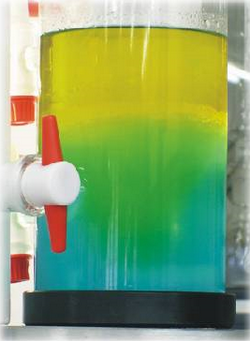Polymer fractionation

Case studies
The reasons for fractionation are as divers as the different applications of polymers are. The following examples are therefore taken from very different areas.
Recovery/purification of polymers produced by means of biotechnology
Fractionation enables the removal of low molecular mass material of polymers stemming from biologiocal sources, yielding products with high purities.
Application in medicine
The short chains as well as the long chains of hydroxyethyl starch are troublesome for its use as blood plasma expander. The short chains leave the body through the kidney very fast and are therefore inefficient. The long chains on the other hand remain in the body, are stored in the skin and induce itching.
Another sample is hyaluronic acid wich is used in eye surgeries as a viscoelastic agent or for the treatment of arthrosis as a natural lubricant. By means of fractionation the properties of hyaluronic acid can be tuned for the application.
Harmful contents in photoresists
Photoresist, like Novolak, are used for the production of electronic circuits in the micro- or submicroscale. For this application the oligomers are disturbing, because they are still sufficient volatile and can be deposited at wrong places. Therefore they impede a further miniaturization. By removing the oligomeric contents this problem can be solved.
Filter dust at the membrane production
During the production of filtration membranes (e.g. from cellulose acetate or -nitrate) very often filter dust is formed, which is blocking the pores of the membrane and decreasing its performance. Furthermore the filter dust can leave the membrane and enter the filtrate. The filter dust consists of the short chains of the membrane material and is transported during the production according to the phase inversion process towards the surface of the forming membrane. At this place it precipitates and blocks the pores. A removal of the short chains reduces the formation of filter dust markedly.
Production of samples with different molecular masses
By means of the fractionation of broadly distributed samples one can obtain fractions differing in the molecular mass. This is for example necessary, if relations between polymer properties and its molar mass shall be examined, but no suitable samples are availabe. A familiar example for a molecular mass dependent property is the hydrodynamic radius of polymers in solution: The Kuhn-Mark-Houwink relation shows the dependence between the intrinsic viscosity and the chain length.
Shelf life of polymers
Certain components can reduce the shelf life of poylmers. This can be e.g. impurities or the short chain material of the polymer itself (as they act as plasticizer or because the end groups have a negative influence). By means of fractionation these components can be removed or reduced to an accaptable amount.
Fractionation according to chemistry
Copolymers (like Polystyrolacrylnitril, SAN) often possess not only a distribution of the molecular mass but also in chemical composition. Under certain circumstances it is possible to fractionate these polymers according to chemistry and therefore opimize their properties.
Fractionation according to architecture
During the sythesis of polymers with complex molecular architecture, like branched polymers or stars, it often happens that linear chains or stars with lower number of arms are formed as unwanted side products. By means of fractionation these components can be removed.
Standards for analytics
By means of repeated fractionation of a broadly distributed sample it is possible to obtain samples with narrow distributions. These fractions can be used as standards, e.g. for the gel permeation chromatography (GPC/SEC).
The here mentioned case studies of polymer fractionation were done during the employment as scientific assistant in the working group of Prof. Dr. B. A. Wolf at the Johannes Gutenberg-Unviersity of Mainz. These case studies are all already published.
